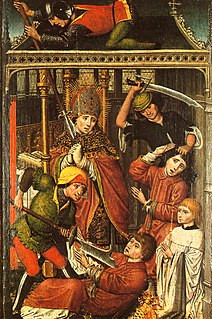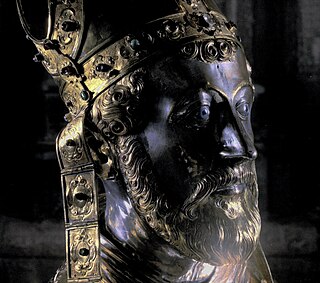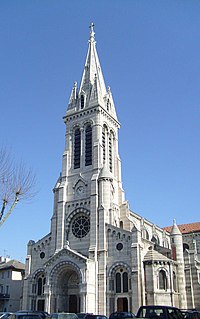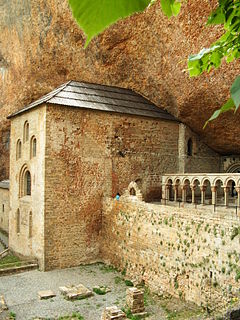Related Research Articles

Hubertus or Hubert was a Christian saint who became the first bishop of Liège in 708 AD. He was the patron saint of hunters, mathematicians, opticians, and metalworkers. Known as the "Apostle of the Ardennes", he was called upon, until the early 20th century, to cure rabies through the use of the traditional St Hubert's Key.

Amandus, commonly called Saint Amand, was a bishop of Tongeren-Maastricht and one of the great Christian missionaries of Flanders. He is venerated as a saint, particularly in France and Belgium.

Saint Lambert or Lambrecht of Maastricht was the bishop of Maastricht-Liège (Tongeren) from about 670 until his death. Lambert denounced Pepin's liaison with his mistress Alpaida, the mother of Charles Martel. The bishop was murdered during the political turmoil that developed when various families fought for influence as the Merovingian dynasty gave way to the Carolingians. He is considered a martyr for his defence of marriage. His feast day is September 17.

Saint Remigius, French: Remi, Rémi or Rémy, was the Bishop of Reims and "Apostle of the Franks". On 25 December 496 he baptised Clovis I, King of the Franks. This baptism, leading to the conversion of the entire Frankish people to Christianity, was a momentous success for the Church and a seminal event in European history.

Saint Servatius was bishop of Tongeren —Latin: Atuatuca Tungrorum, the capital of the Tungri—. Servatius is patron saint of the city of Maastricht and the towns of Schijndel and Grimbergen. He is one of the Ice Saints. His feast day is May 13.

The Roman Catholic Diocese of Gap and Embrun is a suffragan diocese of the Latin Rite of the Roman Catholic Church in the ecclesiastical province of the Metropolitan Archdiocese of Marseille in Provence-Alpes-Côte d'Azur region, southern France.

Remigius de Fécamp was a Benedictine monk who was a supporter of William the Conqueror.

Saint Candidus was a commander of the Theban Legion, which was composed of Christians from Upper Egypt. He is venerated as a Christian saint and martyr.
Saint Trudo was a saint of the seventh century. He is called the "Apostle of Hesbaye". His feast day is celebrated on 23 November.

The Roman Catholic Diocese of Valence (–Die–Saint-Paul-Trois-Châteaux) (Latin: Dioecesis Valentinensis ; French: Diocèse de Valence is a diocese of the Latin Church of the Roman Catholic Church in southern France. The contemporary diocese is co-extensive with the department of Drôme.

Gondulphof Maastricht, sometimes of Tongeren was a bishop of Tongeren-Maastricht venerated as a Roman Catholic and Eastern Orthodox saint. Together with Saint Servatius and Saint Monulph, he is one of the patron saints of the city of Maastricht.

The Roman Catholic Archdiocese of Rennes, Dol, and Saint-Malo is a diocese of the Latin Rite of the Roman Catholic Church in France. The diocese is coextensive with the department of Ille et Vilaine. The Archdiocese has 8 suffragans: the Diocese of Angers, the Diocese of Laval, the Diocese of Le Mans, the Diocese of Luçon, the Diocese of Nantes, the Diocese of Quimper and Léon, the Diocese of Saint-Brieuc and Tréguier, and the Diocese of Vannes.

Christianity has a strong tradition of pilgrimages, both to sites relevant to the New Testament narrative and to sites associated with later saints or miracles.

Monulph was a sixth-century bishop of Tongeren and Maastricht, and is revered as a Roman Catholic saint.

The Roman Catholic Diocese of Liège is a diocese of the Latin Rite of the Roman Catholic church in Belgium. The diocese was erected in the 4th century, and has a long and complicated history. Currently the diocese is a suffragan of the Archdiocese of Mechelen-Brussels. Its modern version covers the same territory as the Belgian province of Liège, but it was historically much larger.

Gerard van Groesbeeck (1517–1580) was a prelate who became the 88th Bishop of Liège, as well as Prince-Abbot of Stavelot and a cardinal of the Catholic Church.
The Diocese of Maastricht was a Roman Catholic jurisdiction in parts of present Netherlands and Belgium, which has been nominally revived as a Latin titular bishopric.

The Pilgrimage of the Relics or Maastricht Septennial Pilgrimage is a seven-yearly Catholic event in the Dutch city of Maastricht. Originating in the Middle Ages, it developed from a pilgrimage to the grave of Saint Servatius into the present-day religious, historical, cultural and commercial enterprise. Highlights in the programme are the displaying or unveiling of the relics in the main churches and secondly, the processions with the town's main relics. The next pilgrimage will take place in 2025.

Christianization of the Franks was the process of converting the pagan Franks to Catholicism during the late 5th century and early 6th century. It was started by Clovis I, regulus of Tournai, with the insistence of his wife, Clotilde and Saint Remigius, the bishop of Reims.
References
- ↑ "Saint Falco of Maastricht" saints.sqpn.com
- ↑ Frans Theuws, Mayke de Jong and Carine van Rhijn, Topographies of power in the early Middle Ages (2001), p.164
- ↑ Régis de la Haye, De bisschoppen van Maastricht (1985), p.39
- ↑ Catholic Encyclopedia of 1913
- ↑ Christian Settipani, Les ancêtres de Charlemagne (1989)